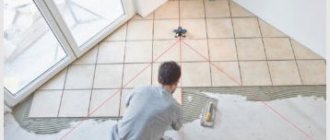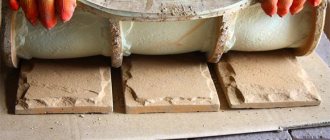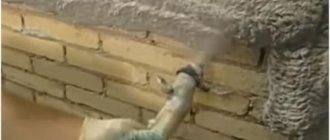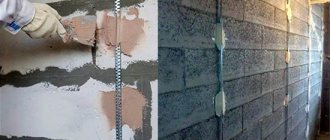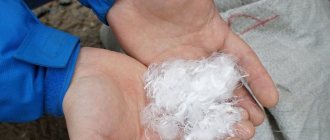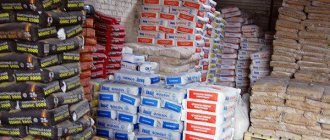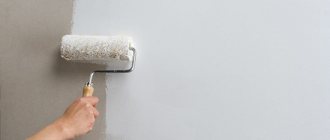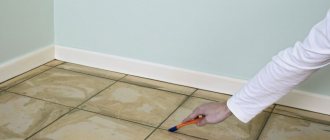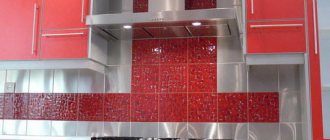If you are wondering how long it takes for tile grout to dry, you need to take into account its properties. Different types of materials in this group harden at different rates, which is due to differences in structure and composition.
When installation work continues ahead of schedule, when the grout has not yet dried, this may cause a reduction in the service life of the coating. As a result, after some time you will have to make repairs or re-lay the cladding on the wall/floor.
What is grout used for?
First of all, such mixtures affect the appearance of the coating. Tile adhesive is characterized by a white or gray color, which often disrupts the overall picture of the interior.
To change the tone of tile adhesive, grout solutions are used. They contain a pigment that allows you to improve the external characteristics of the cladding: get a more seamless coating or, conversely, highlight the tile.
Additionally, grout mixtures help prevent the destruction of the subfloor.
When laying tiles in a toilet or bathroom in areas near plumbing fixtures, the likelihood of surface contact with water or hot steam increases. As a result, moisture penetrates under the cladding and contributes to the loss of properties of the tile adhesive (if a hygroscopic composition was used).
If there is a protective layer in the form of grout, the service life of the cladding increases.
In addition, the treatment of tile joints helps protect these areas from rapid contamination. The grout is characterized by a fine-grained structure. This allows for a smoother surface between the tiles. As a result, contaminants are less actively retained on the coating
.
Another reason to use grout is its ability to strengthen the siding. Most modern compositions of this group are characterized by increased strength, sufficient elasticity, and can withstand changes in temperature and moisture. This allows you to further strengthen the coating.
The properties of grouting compounds are also noted, such as the ability to prevent the formation of fungus on the surface. Thanks to this, it becomes possible to use tile coverings in rooms with high humidity. Grout mixtures of this group do not allow fungi to develop, which is due to the structure of the materials and their composition.
Such mixtures are used to improve the properties of the rough base and cladding. Tile adhesive is characterized by moderate strength, but does not withstand constant exposure to negative factors. For this reason, the base begins to collapse faster. Cracks appear in the space between the tiles, the coating is deformed with the constant expansion of the base material.
Stages of doing wet grouting with your own hands
The procedure consists of several stages. To carry out wet grouting, you will need a sponge and a suitable container for water. Before each use, the sponge must be thoroughly wrung out.
To carry out wet grouting, you will need a sponge and a suitable container for water.
How to apply grout correctly
The sponge is moistened in clean water and wrung out well. Treat the surface with it to remove traces of grout. It is recommended to make circular movements. These steps must be repeated along the entire perimeter of the cladding. To achieve the same appearance of the seams, you can use a screwdriver. It is recommended to ensure that no unevenness occurs when performing wet grouting.
It is recommended to make circular movements.
Final steps
Finally, use a soft cloth to give the seams a perfect look. After each wipe, be sure to rinse the cloth. The surface is thoroughly wiped and left for 15 minutes. Then the sealant is applied to the desired areas where the tiles and other elements of the room, such as the bathtub, meet. When the treatment is completed, you should not step on the tiles or seams for some time. How long to wait is indicated on the package.
Finally, use a soft cloth to give the seams a perfect look.
Is it possible to do without grout?
If the tiles will be laid, for example, on a wall, the likelihood of contact with water and moisture is small, and the coating is not planned to be used for a long period, then in such conditions it is permissible to refuse to grout joints.
When the cladding is not affected by negative external factors (temperature limits, hot steam, water), then the process of destruction of the seams and the rough base will develop much more slowly.
In rooms where there is a significant level of humidity or the surface is subject to intense load (for example, in high-traffic areas), the coating cannot be used without additional protection. If you plan to lay the cladding for a long period, you should close the seam.
If you plan to lay the cladding for a long period, you should close the seam, and grouting the seams in this case is a mandatory step when performing the work.
How to grout tiles on a bathroom wall: stages of work
The process of filling seams is also called fugue. Let's take a closer look at its stages:
- Preparation for the fugue . First, remove the remaining installation elements (crosses, wedges). Then clean the seams from any remaining adhesive mixture and sweep away the debris with a brush. Thanks to this, the filling process becomes easier and eliminates the possibility of blackness appearing when using light-colored grout.
- Selection and preparation of grout composition. This is a simple but important stage. The material for grouting joints is a plastic mass ready for use or a dry semi-finished mixture that requires preparation. The choice of composition is determined by many factors, including the type of tile for finishing. To prepare the dry mixture for work, take a measured part of it, add water and mix thoroughly with a drill whisk. After this, the homogeneous mass is set aside for 5-10 minutes to activate its components and loosened again.
- Filling seams. To perform the work, use a soft rubber spatula. First, they make movements perpendicular to the seam, pressing the grout to its full depth. Then a spatula is passed along the edge of the tile, cleaning off excess. Due to the rapid setting of the composition, you should not process more than 1-1.5 m2 of cladding.
- Formation of neat seams. At the grouting stage, when they are still wet, they are given a finished look. For this purpose, a piece of television cable is used, which serves as a joint. This creates a neat radius seam, and each tile stands out against the general background.
- Removing residual material. After completing the work, traces of the grout remain on the surface of the cladding. To prevent them from drying out, they are first wiped with a damp sponge.
- End of grouting . At the end of the work, wipe the entire tile with a dry cloth. This completely removes the grout components. Every other day, the surface is treated with special plumbing products.
How to grout dark tiles on a wall
As a rule, dark colors are used when lining the floor or the lower part of the walls. In this case, when filling joints, do not use light-colored grout for two reasons:
- firstly, in these places they get dirty;
- secondly, sometimes the dark end of the tile is visible, which visually increases the size of the seam.
Ideally, grout is selected only after laying the tiles.
How to properly fill the joints of light-colored tiles
The grouting process for this material is fundamentally no different from the usual procedure. To highlight each element of the cladding, use compositions that are slightly darker or lighter than the main background. You should be careful with sharp contrasts in tile and grout colors. In this case, the seams can highlight material defects.
How long does it take for tile grout to dry?
There is no definite answer to this question, because it depends on the composition of the mixture, its properties, and the presence of errors during mixing. If you are wondering how long it takes grout to dry, you need to consider that cement is a material that sets more slowly than others. This means that most compositions based on it will maintain viscosity for a long time.
This applies to cement and cement-sand mixtures.
Epoxy and epoxy-cement compositions harden somewhat faster. Given the difference in drying speed, you can only rely on average values. So, in most cases, the mixture sets within a day, but the coating can be used only after 5-7 days. Then the grout will dry not only on the surface, but also inside the layer.
Much depends on the intended purpose of the materials. So, if you plan to drill tiles in a room where there is a high probability of direct contact with hot steam or water, then it is better to start installation work later. If you wait only 3 days from the moment of applying the mixture, there is a high probability of faster destruction of the coating, since the grout will not have time to become durable during this time.
In addition, the drying time depends on the thickness of the layer. If, when applying glue, the space between the tiles was filled insufficiently, unevenness in the seams is eliminated at the grouting stage. In this case, sometimes the layer of material is significant, which leads to an increase in the drying time of the composition. If in this case cement grout was used, then its maximum hardening can be expected 1.5-2 times longer.
What affects drying time?
Under different conditions, the same materials behave differently. To speed up the process of full setting, it is necessary to perform the installation correctly and change the environmental conditions. There are a number of factors that contribute to increasing the period during which the mixture gains strength:
- Material composition: different types of grout set at different speeds, which is due to the difference in the combination of components, as well as the properties of each substance.
- Non-compliance with mixing technology: when changing the ratio of materials, using raw mixtures, increasing/decreasing the initial amount of water, poor-quality mixing of large fractions of the composition, a loss of grout properties is observed (it does not gain strength, absorbs moisture).
- Cement mixtures must be cured for a certain period before work begins.
- The grout is applied to slightly moistened surfaces; if there is water left in the space between the tiles or the coating is too moistened, the mixture will take a long time to dry. In addition, its application under such conditions can lead to loss of properties and reduced adhesion to tile adhesive.
- Removal of excess grout should be done soon after application (10-40 minutes), which will allow the joint to be formed of sufficient thickness and speed up the drying of the material.
- Unsuitable environmental parameters: if the tiles are laid in the bathroom, the grout may be affected by water, hot steam, and temperature changes. In such conditions, the drying rate is reduced, so it is recommended to begin use no earlier than 7 days after application.
How to update the grout between tiles?
After completing the finishing work, you can enjoy the fruits of your labor. However, in some cases the feeling of satisfaction is short-lived. And after some time, the grout loses its freshness, and the appearance of the finish becomes not at all as wonderful as it was after installation.
- There are several ways out of the situation. To update, the grout is bleached using hydrogen peroxide and soda. Having mixed these two components, the resulting substance is applied to the seams using a regular toothbrush. But it is better and faster to update the openings using a steam cleaner.
When the appearance of the tile ceases to please you completely, you should not rush to dismantle it or run to the store for a new one in order to urgently make the next repair.
Often the cause of the unsatisfactory condition of the ceramic finish is contamination of the joints. In some cases, it may be enough to simply grout the old tile joints. There are several ways to achieve your plan.
- The most practical and easiest method is dyeing. However, in this case, the appearance of the tiles will change for no more than six months. In addition, difficulties may arise with finding a paint composition suitable for a humid environment.
It is also possible to apply a new layer of grout over the old one. But this makes sense if the seams between the modules are sufficiently voluminous and have recesses of at least two millimeters.
- Radical, and therefore effective, measures to update the appearance of the cladding include a complete replacement of the contents of the joints. But how to remove grout from tile joints?
Fresh grout material, no more than a day old, can simply be soaked with water if for some reason it has become objectionable. And after thorough cleaning of the intermodular openings and complete drying, there is a second chance to do everything in the best possible way.
You can use sandpaper rolled into a tube when the grout has had time to set, but not much time has passed since the repair work. If the surface of the tile is contaminated with old grout, you should resort to using regular sunflower oil, which will help remove unpleasant residues.
When the described options are not suitable for eliminating outdated grout due to its long service life, there is nothing left to do but resort to a mechanical method of getting rid of the contents of intermodular openings.
- Before starting work, a sharp object (you can use a knife) should be drawn straight along the tile seam, and then, changing the angle of inclination, do the same two more times, only a little to the left and to the right of the original line. Next, use a drill and an electric drill.
- If the tiles have become completely unusable: they have broken off and hardly stick to the surface, easy repairs and cosmetic measures will no longer be possible.
- The mechanical method of removing old grout will negatively affect the condition of the old tile, and it may well happen that it will simply begin to crumble. The best decision in this case is to replace the old finish with a qualitatively new one, which will be more beautiful and more comfortable.
When can you start cleaning?
It is necessary to pay attention to the area where the tiles are located. Thus, it is recommended to clean the lining on the floor later, when the solution has set, since any deformation of the fresh material can lead to destruction of the mixture layer during operation. You can begin cleaning the wall covering 1-2 days after applying the grout.
However, in this case it is permissible to use a damp cloth. General cleaning, accompanied by a thorough washing of surfaces, even in this case is not recommended for a week.
Tools and materials needed for work
Of the entire renovation process involving laying tiles, filling the joints with grout is the simplest job, requiring only perseverance. For it you will need:
- ready or dry grout;
- construction mixer or drill with an attachment;
- container for preparing grout;
- rubber spatulas of different widths. If you intend to work using an epoxy compound, the tool should be made of hard rubber;
- paint brush;
- stationery knife;
- soft sponge;
- grout float.
There should be a container of clean water at hand. Due to the fact that grout mixtures consist of chemical components, it is necessary to work with them wearing rubber gloves and a respirator.
Features of different types of grout
Main options:
- cement-sand – contains Portland cement and fine-grained sand, has moderate strength, the disadvantage is weak hygroscopicity;
- polymer mixtures (polyurethane, silicone) - characterized by increased elasticity, sufficient strength, do not absorb water and are often used in rooms with high humidity levels;
- epoxy grout - characterized by high strength, moisture resistance, contains resin and hardener, and is second only to the furan mixture in terms of reliability.
Main types of mixtures
These varieties are not supplied as a dry powder, but as a paste. Often there is a two-component material that is supplied in the form of two elements. They must be mixed immediately before use.
After preparing according to the instructions, the consistency of the mixture is similar to regular, so it is applied in the same way.
But epoxy or silicone grout sets and hardens much faster, so it needs to be prepared in small batches, applied promptly, immediately remove excess, and clean the surface of dirt before final setting.
It must be remembered that these types of caulking material are incredibly difficult to remove once dry. Their advantages include high strength, resistance to moisture, chemical exposure, and temperature changes.
Modern manufacturers annually fill the market with new, more advanced products. Today we can distinguish the following types of tile grout:
- Cement fugue - based on fine sand and Portland cement with the addition of modifying components.
- Latex is a more advanced version of cement grout; it has water-repellent properties, making it ideal for the bathroom.
- Furan is a chemically stable, ultra-dense mixture of black color.
- Epoxy is a viscous putty containing epoxy resins, which make it more durable and water-resistant.
Now you can proceed to the final stage - grouting the joints and treating them with sealant. A well-made grout can mask existing installation defects, while a poorly done grout can completely destroy the impression of a flawless installation.
First check that the adhesive on which you laid the tiles is completely dry and thoroughly clean the seams from debris and dirt. Remove any spacers (crosses) left between the tiles after installation. Some manufacturers of dividers state that they can be left in the seams and covered with grout. But in this case, the layer of grout above the dividers will be thinner, so it will have a different color after it hardens and can ruin the appearance of the entire grout.
If you are working with glazed tiles, you can immediately start grouting the joints. If you are laying unglazed tiles, you should first dampen the top and sides of each tile to prevent too much moisture from being sucked out of the grout. Some tile installers use garden sprinklers to spray water over the surface of the tiles.
Regardless of which method you choose, the main thing is not to overdo it. Puddles of water left on the tiles or in the grout can damage the grout, which can then crack. (To avoid doubts about carrying out such preparation of tiles and joints, it is better to consult with the grout manufacturer).
- Cement fugue - based on fine sand and Portland cement with the addition of modifying components.
- Latex is a more advanced version of cement grout; it has water-repellent properties, making it ideal for the bathroom.
- Furan is a chemically stable, ultra-dense mixture of black color.
- Epoxy is a viscous putty containing epoxy resins, which make it more durable and water-resistant.
Furan mixtures are not used at home; latex and cement mixtures are mainly in demand.
All of them dry quite quickly, and therefore it is necessary to work with mastic quickly.
You can continue finishing work after exactly as long as the tiles on the floor, fixed with tile adhesive, dry. Previously, you cannot walk around the room, as the integrity of the masonry may be damaged, the tiles will move and spoil the surface level.
First you need to prepare the tool. You will need a rubber spatula; it can be used to conveniently apply mastic and distribute it over the joint. You may also need a foam sponge, cord to fit the joint, or a special seam shaping tool.
In order for the tile adhesive to dry quickly, it must be prepared strictly according to the manufacturer’s recipe
Prepare the solution. If you are using ready-made grout, it is advisable to put a small amount of it in a separate container and tightly cover the remainder with a lid so that it does not dry out too quickly.
For the powder mixture, you need to prepare clean water. Mix dry ingredients in small portions. Add water according to the instructions, but little by little, so that the mass does not turn out too liquid, it should be plastic and not crumble into lumps.
You need to apply the grout inside the seam, pushing it with a spatula, having previously cleaned off excess glue and dust. To improve shrinkage, it is recommended to moisten it after the top layer has dried a little, and then repeat the application. You should work quickly and confidently.
How to avoid mistakes and not affect the drying time?
To avoid thickening of the layer of material in the space between the tiles, you should use special tools for applying grout:
- Rubber spatula - used in most cases, but due to its small width it is not recommended to use it if you plan to perform a large amount of work. A spatula with these characteristics is suitable for applying different materials.
- Grater - used when finishing mosaics, since in this case the use of a spatula increases the installation time. A construction float is also suitable for filling joints in large areas, which allows you to speed up work.
- Syringe gun - designed for filling deep seams. This tool is often used for applying polyurethane and silicone mixtures; thanks to it, neat seam joints are obtained.
- A cone is an alternative to a pistol. This option is suitable for cases where it is necessary to protect porous base material.
Common mistakes when grouting joints and how to avoid them
Typical mistakes do not allow you to obtain high-quality and beautiful cladding. Therefore, it is worth familiarizing yourself with common cases when the wrong approach harms your work. Grouting on dirty walls is unacceptable. Be sure to remove any remaining glue. The rule also applies to inventory. It is allowed to work only with clean tools. It is better to have several different spatulas, separate for grout and glue.
First remove the solution from the seams. It is impossible to apply grout without such a procedure. Before applying a new grout layer, the old one is removed. It is a mistake to mix the mixture with a drill. The tool speeds up the process, but degrades quality due to air entry. Metal spatulas should be avoided. A common mistake that occurs frequently is mixing a large amount of mixture at once. It is better to knead in portions, processing a small area of lining.
It is allowed to work only with clean tools.
Grouting is a simple process if you take it seriously and study the process carefully. Careful adherence to the recommendations will allow you to obtain high-quality, clean and beautiful cladding.
Removing excess grout
It is recommended to remove excess mixture within the first 10-40 minutes after application. To do this, use a dampened and well-wrung out cloth. Traces of grout can be removed after 1 day. For this use:
- A foam glove soaked in vegetable oil is used to clean areas of the cladding that have been dirty, and the fatty components are cleaned with alcohol.
- Sandpaper - to eliminate unevenness in the space between the tiles.
- Citric acid - to remove stains.
- Soda, which is applied to damp tiles to remove white marks.
When it was not possible to remove the remaining grout on the 2nd day, it is recommended to begin intensive cleaning of the coating after the mixture has completely hardened.
Features of the work
To grout tiles, several types of mixtures are used, differing in structure and content of components. This determines the features of their use. Cement-based fugue is easy to work with and its “lifetime” is 30-40 minutes. This is quite enough to correct minor defects.
In order for the color of the cement joints to be the same, it is necessary to strictly observe the ratio of the components.
Epoxy grout is a material that requires a short period of work. This is due to the fact that it sets quickly and hardens within half an hour. Therefore, highly qualified tilers with good professional skills work with epoxy grout. Restrictions on its use are the seam width from 5 to 12 mm with a maximum depth of 10 mm.
The most modern fugue is silicone grout. It is usually used in the middle range of tile gap widths (2-7 mm). For application, a special gun is used, which allows you to form a neat continuous seam.
Overview of methods
Width of gaps between tiles
This question does not relate directly to the topic “How to grout joints on tiles,” however, it may also be of interest to those owners who are still little familiar with the features of the stages: both with the installation of products and with grouting joints.
There are no strict standards regarding the width of the gaps. However, you need to know that very large distances between products somewhat reduce the mechanical strength of the finishing coating. On the other hand, they are able to give the surface a clear geometric pattern.
In general, there is a direct relationship between the width of the joints and the size of the ceramic products used. For example:
- for tiles whose side is less than 100 mm, it is recommended to leave gaps from 1 to 3 mm;
- with a side of more than 100 mm, the optimal width is 3-8 mm;
- for large edges (up to 300 mm) - 4-10 mm;
- for clinker products - from 8 to 15 mm;
- the ideal for mosaics is 1-3 mm.
As a rule, gaps are larger for floor coverings than for walls.
